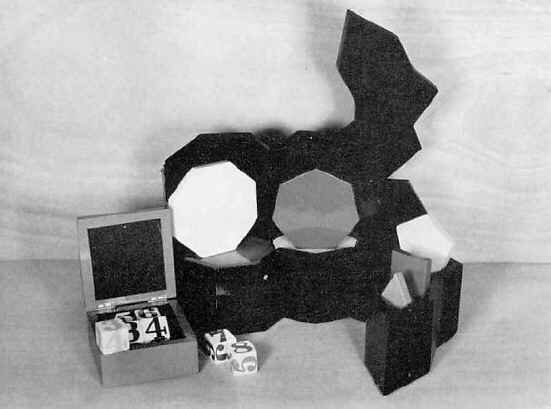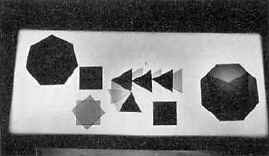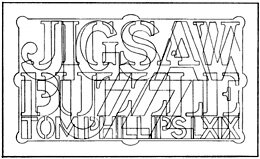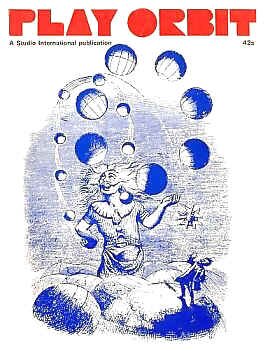John Furnival
Etemenanki
My statement about toys takes the form of a question:
Is mankind becoming ludic
or ludicrous? |
|
|
 |
| This toy consists of a series of three-, four-, five-, six-, seven-, eight-sided bricks, having a common side length, and painted in seven colours: black, blue, red, gold, purple, green, and white. The name ETEMENANKI is derived from a ziggurat temple of the same name |
|
|

|
which is thought to have been the original tower of Babel, each tier of which was decorated in one of the above colours (they still survive in the heraldic form of sable, azure, gules, or, vert, purpure, and argent).
The bricks can be used in a number of different ways.
They can be used simply for making flat patterns (my own children are very fond of using them to make people and animals); or they can be used in stacks. If they are hinged they can make complicated three-dimensional balancing forms (in this case it is essential to have a simple removable-pin hinge, so that the bricks can be re-arranged quickly).
It is also possible to play games with these bricks, and for this purpose I have provided seven dice, each numbered three to eight in one of the seven colours. It is best to make your own rules for these games, but the following set of rules will give some idea of the possibilities.
GAME: With two sets of bricks (i.e. one of each colour for each shape), race across any large area and back again, by joining bricks along their sides.
RULES:
1. Odd-numbered side shapes can only be placed against even-numbered side ones.
2. No colour can be put against itself.
3. If, having used up all your bricks, you still have not reached home, you may leap- frog yourself, by joining your first brick to your last one, and so on, as your throws of the dice permit.
4. Opponents’ bricks must not touch each other; you can obstruct your opponent by forcing him back, or against a wall. If his bricks touch a wall, then you are the immediate victor.
5. The bricks are arranged in the box in a certain order, and may only be taken out a layer at a time, i.e. before you can start using any of the bricks from the second layer you must have played all the bricks of the first layer.
6. To start the game, both opponents throw the seven dice. He with the highest total starts.
An interesting variation of this game is a slow-race, i.e. a race in which the first person home is the loser. |
|
Using vacuum-forming, these bricks could be produced to any scale, and it would be nice to produce quite large ones, so that people could have races with them on railway-station platforms and other places where one always has to wait much longer than one officially should.
I have also provided an ‘executive’ version, using coloured perspex on a light table. As the name suggests, this is for executives to fiddle around with while they are having think-ins and re-think-ins, but, of course, it can also be used to calm people who are waiting for executives, or simply for people who are waiting to have their teeth filled. |
|

below
Tom Phillips Jigsaw puzzle 1969
An interlocking wooden jigsaw puzzle
cut by B. T. Lea, Chelsea Embankment, London;
15 x 20 inches
Photograph by David Knight
|
|

|
|
above
John Furnival Etemenanki 1969
A toy based on the shape of a ziggurat composed of painted wooden bricks which can be used for making patterns or playing games with the aid of dice: dice 2 x 2 x 2 inches in box 4 x 7½ x 7 inches; six sizes of bricks from ½ x ½ x 2½ inches to ½ x 7½ x 7½ inches in box 7 x 24 x 30 inches
Photograph by Don Flowerdew
above left
Etemenanki -’executive’ version 1969 Coloured perspex bricks on a light table; 21 x 24½ x 34½ inches; bricks from ¼ x 2½ x 2½ inches to ¼ x 7 x 7 inches
Photograph by Don Flowerdew |
|

Tom Phillips
The jigsaw is the drawing
|
In this toy some aspects of the concept 'puzzle' are discussed by the conventional technique of reductio ad (almost) absurdum.
(puzzle is toy as game)
(puzzle is life-problem surrogate, emitting danger)
i.e.
A TOY IS SOMETHING YOU HAVE FUN WITH YET DOESN'T EAT YOU IN THE END. A puzzle-toy is a luxury worry (absorbing enough to replace real ones and possible enough of completion to be unlike real ones in that the end of worry is in sight).
Some staple elements . . . irritant. Difficult enough to produce sensation of pride in the solving. Battle/contest with oneself and the deviser. Elegantly devised and with elegant elements (pleasure in handling).
The content of this puzzle is merely the name of the type of puzzle plus the deviser's advertisement. The pieces are all virtually blank, the drawing existing only when the puzzle is assembled (the puzzle is cut along the lines of the drawing). |
|
|

|
Jasper Jewett
Jigsaw puzzle |
|
|
|
A toy is something that amuses and engages the imagination. Toys have a curious quality which distinguishes them immediately from more sophisticated forms of art.
Although playing with a toy in a physical sense seems to be an important factor, the object that cannot be handled, like toys in a glass-fronted cabinet, can also have a great fascination.
The Jigsaw puzzle has twenty-five symmetrical double-sided interlocking pieces and can be arranged in over 12,000,000 different ways. |
|
| This toy is not my invention, but a development of a comparatively modern idea to suit my three children. The activities of toy-making and sculpture have become parallel and sometimes indivisible. For example, the form of Laddermax, though consistent with the original idea, is based on a maquette for a sculpture, the final version of which is not yet complete. This maquette owes its origins to a flotilla of battleships left in my studio by my children. If it is true, as Patrick Murray says, that a toy is fundamentally an expression of some inward need, that it meets a demand, then it may be that making sculpture, which is largely static, is not enough, and that the making of objects which demand participation and include movement and colour and are concerned with immediate pleasure, is more significant to me as an artist than as a father. Perhaps when I no longer have home-grown and captive participants to make toys for, my sculptures will undergo a radical change. |
|

right
Michael Pennie Laddermax 1969
Wooden construction with three tumbling blocks
48 inches high x 30 inch base
Photograph by Don Flowerdew
|
|

left
Jasper Jewett Jigsaw puzzle 1969
Double-sided jigsaw puzzle in painted wood consisting
of twenty-five elements in a frame; 33 x 33 inches
|
|
 |
|

|
|
graphics and catalogue cover design
Ken Hughes
organization
Jasia Reichardt
|
|
|
Kenneth Armitage
Big Doll
|
|
|
| Toys are a part of playing. Playing involves the creative or fanciful participation in isolated real-life processes or skills without regard to scale, time, place, or consequence. Most people achieve in ‘play’ a degree of seriousness, concentration, freshness, spontaneity or abandon that can exceed or differ from their normal everyday behaviour, and when imaginative, it is hard -except in degree- to make clear distinction between play and what are known as the arts. Playing requires a voluntary attitude of mind and toys are devices for promoting or directing it. Sport is play sanctified and made elaborate for the conventional adult mind. |
|

right
Kenneth Armitage Big Doll 1969
Doll on table base made of fibreglass, wood and
stainless steel painted white; 72 x 24 x 28 inches
Photograph by Don Flowerdew
|
|



